Taoren – Peach Kernel, a Chinese medicine. It has the effects of promoting blood circulation and removing blood stasis, moistening the intestines and relieving constipation, relieving cough and relieving asthma. It is used for amenorrhea, dysmenorrhea, lumps, lung abscesses, intestinal abscesses, injuries from falls, dry intestines and constipation, cough and asthma.
Blood circulation and blood stasis medicine, prescription type
Ingredients and properties Main effects Indications Analysis of medicinal properties/prescription explanation Usage and dosage Adverse reactions Contraindications Precautions Pharmacological action implementation standards Notes
Ingredients, this product contains amygdalin, amygdalin, volatile oil, and fatty oil. The oil mainly contains oleic acid glyceride and a small amount of linoleic acid glyceride.
Properties, peach kernel is flat and long oval, 1.2-1.8cm long, 0.8-1.2cm wide, and 0.2-0.4cm thick. The surface is yellow-brown to reddish brown, densely covered with granular protrusions. One end is pointed, the middle is swollen, and the other end is blunt and slightly skewed, with a thin edge. There is a short linear hilum on one side of the tip, and a slightly darker and less obvious chalaza at the round end, from which many longitudinal vascular bundles are scattered. The seed coat is thin, with 2 cotyledons, off-white, and rich in oil. The smell is slight and the taste is slightly bitter. Peach kernel: It is oval, small and thick, about 0.9cm long, about 0.7cm wide, and about 0.5cm thick.
Main effects: promoting blood circulation and removing blood stasis, moistening the intestines and relieving constipation, relieving cough and relieving asthma.
Indications: used for amenorrhea, dysmenorrhea, lumps, lung abscesses, intestinal abscesses, injuries from falls, dry intestines and constipation, cough and asthma.
Medicinal properties analysis/prescription explanation: It is flat in nature, bitter and sweet in taste, and slightly toxic. It enters the heart, liver, and large intestine meridians.
1. The processing method of peach kernel has been said to remove the skin and tip since ancient times. In Zhang Zhongjing’s “Treatise on Febrile Diseases” and “Golden Chamber Synopsis”, all the prescriptions using peach kernels are marked with peeling and tip removal. In modern clinical practice, peach kernels are mostly used in Weihai. Raw and fried peach kernels are relatively less used. Many scholars have conducted discussions through experiments and clinical practice on whether the peeled tip can reduce toxicity or enhance efficacy. In short, peach kernels contain more amygdalin. If peach kernels are used in large quantities, it is better to peel the tip to avoid poisoning. The total ash content of peach kernels peeled or not after being shelled is lower than that of raw peach kernels, indicating that the shelling process plays a purification role. The shelling process is a process of water preservation and decoction, which is easy to cause partial loss of effective ingredients. Therefore, it is necessary to peel the skin in a Western way. On the one hand, it can clean the medicine. On the other hand, peeling the peach kernel is conducive to the decoction of effective ingredients and can avoid poisoning. However, the Western processing time should be shortened as much as possible to avoid excessive loss of effective ingredients. 2. Peach kernels can promote blood circulation and induce abortion, so pregnant women should not use it. People with weak qi and blood and no blood stasis should use it with caution. Peach kernels contain amygdalin, which can be decomposed into hydrocyanic acid in the body, which can paralyze the respiratory center of the medulla oblongata. Taking a large amount of it can cause poisoning. Therefore, the dosage should be controlled when using it to prevent poisoning. In addition, there are clinical reports that people who have allergic reactions due to contact with peach kernels show itching on the back of the hands at the contact site, red rashes on the exposed site, and itching.
3. The focus of peach kernel effects is on promoting blood circulation and menstruation, removing blood stasis and relieving pain. It is used to treat headaches, sore throats, chest pain, lung abscess, abdominal pain, irregular menstruation, dysmenorrhea, amenorrhea, lumps, abdominal pain after childbirth, hernia pain, pain, sores, swelling and pain, and rheumatism caused by blood stasis; cough and asthma, used to treat cough and asthma; moisturizing the intestines and laxatives, used to treat dry intestines and constipation.
用法用量
Decoction, 5-10g, mashed for use; peach kernel frost should be wrapped and decocted in decoctions.
Adverse Reactions
The amygdalin in peach kernels decomposes more hydrocyanic acid in the body, which first excites and then paralyzes the central nervous system, among which respiratory paralysis is the main cause of death. In addition, hydrocyanic acid has a local anesthetic effect on the skin and an irritating effect on the mucous membrane. The main manifestation of peach kernel poisoning is first of all damage to the central nervous system, with dizziness, headache, vomiting, palpitations, irritability, followed by confusion, convulsions, and respiratory paralysis that endangers life. There are also reports of skin allergies such as skin tingling and rashes. The toxic reaction of peach kernels is mainly caused by excessive oral doses or improper use. Therefore, the clinical dosage should not be too large, and children should be prohibited from eating it. At the same time, pregnant women, those with blood deficiency, blood dryness, and body fluid deficiency should use it with caution. When peach kernel poisoning, according to the severity of the reaction, it can be treated by intravenous injection of sodium thiosulfate, potassium permanganate or hydrogen peroxide solution for gastric lavage, or it can be taken frequently with Chinese medicine licorice, jujube, mung bean, etc. decocted juice.
Taboo
1. Peach kernel has the effect of dispersing blood stasis and breaking blood. If used improperly, it will cause blood to continue to flow and damage yin and blood. Therefore, it is not suitable for people with qi deficiency and blood weakness, and body fluid deficiency without blood stasis. If the patient has amenorrhea due to blood deficiency, scanty menstruation, dry stool due to lack of body fluid and dry intestines, or if the patient has blood deficiency and weak qi after childbirth, abdominal pain and emptiness, it should not be used.
2. Peach kernel has a strong ability to remove blood stasis, which can cause abortion, which is not good for pregnant women and fetuses, so it should not be used.
3. Peach kernel has the function of opening knots and relieving stagnation, and moistening the intestines. The herbal books of all dynasties believe that it can disperse but not collect, and it can purge but not replenish. Therefore, it is not suitable for people with loose stools. If the patient has spleen deficiency and dysfunction of transportation and transformation, poor appetite and abdominal distension, and is prone to diarrhea and loose stools, it should be used with caution. If you want to use it, you should also use it with spleen-strengthening and qi-tonifying drugs to avoid hurting the spleen.
4. Peach kernel has the effect of promoting the contraction of uterine smooth muscle, so it is not suitable for those with threatened abortion.
5. The amygdalin contained in peach kernel has an inhibitory effect on the respiratory center, so it should be used with caution for those with impaired lung function.
防范措施
1. Peach kernel has the function of anticoagulation, but it has the disadvantage of consuming blood and moving blood, so it is not suitable for people with blood deficiency syndrome; it should be used with caution for people with hemorrhagic diseases or bleeding tendency; it is not suitable for women during menstruation and those with heavy menstruation without stasis.
2. Peach kernel has the effect of moistening the intestines and relieving diarrhea, so people with chronic enteritis and loose stools should avoid taking a large amount of single medicine orally.
3. The dosage of peach kernel and almond should be reduced to avoid amygdalin poisoning
4. The dosage of peach kernel should be reduced when used in combination with anticoagulants. Peach kernel should not be used in combination with antitussive drugs and anesthetics such as codeine, morphine, pethidine, phenobarbital, etc., so as not to aggravate the anesthetic effect and inhibit the respiratory center.
5. Modern pharmacological studies have shown that peach kernel can significantly prolong the bleeding and coagulation time of mice. Peach kernel decoction has a fibrinolytic effect. Peach kernel can excite uterine smooth muscle and promote uterine contraction in primiparas. In addition, peach kernels have laxative, antitussive, analgesic, anti-allergic, anti-inflammatory, antibacterial, anthelmintic, anti-malignant tumor, antioxidant, liver protection and immunomodulatory effects.
6. The toxicity of peach kernels is closely related to the route of administration. The oral toxicity is the greatest, and other routes of administration are basically non-toxic. In order to prevent adverse reactions, the clinical dosage should not be too large. And publicity should be strengthened, and children are prohibited from eating peach kernels.
药理作用
Peach kernel extract can significantly increase cerebral blood flow, increase blood flow in the femoral artery of dogs, reduce vascular resistance, and improve hemodynamics. The extract can improve the surface microcirculation of the liver of animals and promote bile secretion. Peach kernels can significantly prolong the bleeding and coagulation time of mice, the decoction has an inhibitory effect on in vitro thrombosis, and the decoction has a fiber-promoting effect. The 45% fatty oil contained in peach kernels can lubricate the intestines and facilitate defecation. Peach kernels can promote uterine contraction and bleeding in primiparas. The decoction and extract have analgesic, anti-inflammatory, antibacterial and anti-allergic effects. Amygdalin in peach kernel has antitussive and antiasthmatic effects and anti-liver fibrosis effects.
Peach kernel (attached: dried peach)
[Medicinal use] Mature seeds obtained from Prunuspersica (L.) Batsch or Prunus davidiana (C.rr.) Franch., a small tree of the Rosaceae family.
[Nature and flavor and meridians] Bitter, sweet, flat. It enters the heart, liver, and large intestine meridians.
[Effects] Activate blood circulation and remove blood stasis, moisten the intestines and promote bowel movements.
[Clinical application] 1. Used for symptoms such as lumps, lung abscesses, intestinal abscesses, falls and injuries, amenorrhea, dysmenorrhea, and postpartum blood stasis pain.
This product also has a wide range of blood circulation and blood stasis removal effects, and is very commonly used for the above-mentioned blood stasis and obstruction diseases. For lung abscess, it can be used with reed root and coix seed; for intestinal abscess, it can be used with rhubarb and moutan bark; for lumps and masses, it can be used with rhubarb and worms; for pain caused by falls, it can be used with bupleurum and pangolin; for amenorrhea and dysmenorrhea, it can be used with safflower and angelica; for postpartum blood stasis and pain, it can be used with angelica and roasted ginger.
2. Used for constipation caused by dry intestines.
Peach kernel has the effect of moisturizing and lubricating the intestines. It can be used with hemp seed, cypress seed, angelica, apricot kernel, etc. for constipation.
[Prescription name] Peach kernel, peach kernel mud, old peach kernel, single peach kernel (remove the seed coat and crush for use), peach kernel frost (remove oil and make frost for use)
[General dosage and usage] One to three coins, decocted and taken. Peach kernel frost must be wrapped and decocted when added to decoctions.
[Attached medicine] Dried peach: that is, unripe dried fruit, also known as dried peach. The nature and flavor are bitter and slightly warm. It can stop sweating and stop bleeding. It is suitable for night sweats caused by yin deficiency and hemoptysis. The general dosage is three to five coins, decocted and taken orally.
[Comments] 1. Peach kernel tastes bitter and sweet and is flat in nature. It can enter the heart, liver, and large intestine. It has a wide range of blood circulation and blood stasis removal effects and can be used to treat various diseases caused by blood stasis. In terms of treatment, it is good at treating internal abscesses, such as lung abscess; intestinal abscesses are often treated as a key medicine. Is it because of its unique properties? It is rich in fat and moist, and has the function of moistening the intestines and relieving constipation. However, it is rarely used in recent clinical practice for moistening the intestines and relieving constipation. It should not be used by women with excessive menstruation or pregnant women.
2. Peach kernel and safflower are both blood circulation and blood stasis removal drugs, and their functions are very wide. They are often used in combination. However, peach kernel is good at treating lung abscess and intestinal abscess, and has the effect of moistening the intestines and relieving constipation; safflower is good at promoting blood circulation and regulating menstruation.
This product is the peach Prunus persica (.Batsch or Prunus serrata) of Qiangwei Village. davidiana (Carr.) Franch, the dried mature seeds. Harvest the fruits when they are ripe, remove the pulp and shell, take out the seeds, and dry them in the sun.
[特性]
The peach kernel is flat and long oval, 1.2~1.8cm long, 0.8~1.2cm wide, and 0.2~0.4cm thick. The surface is yellow-brown to reddish brown, densely covered with granular protrusions. . One end is pointed, the middle is swollen, and the other end is blunt and slightly tilted, with thinner edges. There is a short linear hilum on one side of the tip, and a slightly darker and less obvious chalaza at the round end, from which many longitudinal vascular bundles radiate. The seed coat is thin, with 2 cotyledons, off-white, and rich in oil. The smell is slight and the taste is slightly bitter.
It is oval in shape. shaped, small and thick, about 0.9cm long, 0.7cm wide, and 0.5cm thick. Peach kernel [Identification]
(1) Peel powder (or dissociated) slices of this variety: Peach kernel stone cells are yellow or yellow-brown, shell-shaped, helmet-shaped, arched or oval when viewed from the side, 54~153um high, about 180um wide at the bottom, thicker on one side of the wall, with fine and dense layers; round, rounded polygonal or square-shaped when viewed from the surface, with large and dense pores on the bottom wall
Peach kernel stone cells are light yellow, orange-yellow or orange-red, shell-shaped, rectangular, oval or long strips when viewed from the side, 81~198(279)um high, about 128(198)ym wide; surface The surface is round, hexagonal, long polygonal or square, with uneven bottom wall thickness and small pores.
(2) Take 2g of the crude powder of this product, add 50ml of petroleum ether (60~90℃), heat and reflux for 1 hour, filter, discard the petroleum ether liquid, wash the residue with 25ml of petroleum ether, discard the petroleum ether, evaporate the residue, add 30ml of methanol, heat and reflux for 1 hour, cool, filter, and take the filtrate as the test solution. Take another bitter almond paste reference substance, add methanol to make a solution containing 2mg per 1ml as the reference solution. According to the thin layer chromatography method (General Rule 0502), take 51 of the above two solutions and apply them to the same tridacna G On the thin layer plate, use chloroform-ethyl acetate-methanol-water (15:40:22:10) at 5~10℃ for 12 hours as the developing agent, develop, take out, immediately spray with phosphomolybdic acid sulfuric acid solution (phosphomolybdic acid 2g, add 20ml water to dissolve, then slowly add 30ml sulfuric acid, mix well), and heat at 105℃ until the spots are clearly colored. In the chromatogram of the test sample, spots of the same color appear at the corresponding positions of the chromatogram of the reference sample.
[检查]
The water content shall not exceed 7.0% (General Rule 0832 Method 2)
The acidity shall be determined according to the acidity determination method (General Rule 2303).
The acid value shall not exceed 10.0.
Carbonyl value Not more than 11.0.
Heavy metals and harmful elements are determined according to the lead, cadmium, arsenic, mercury and copper determination method (General Rule 2321 atomic absorption spectrophotometry or inductively coupled plasma mass spectrometry). Lead shall not exceed 5mg/kg; cadmium shall not exceed 1mg/kg; arsenic shall not exceed 2mg/kg; mercury shall not exceed 0.2mg/kg; copper shall not exceed 20mg/kg. Aflatoxin is determined according to the mycotoxin determination method (General Rule 2351).
This product contains aflatoxin B per 1000g, which shall not exceed 5ug, and the total amount of aflatoxin G2, aflatoxin G1, aflatoxin B> and aflatoxin B ィ shall not exceed 10ug
【含量测定】
Determined according to high performance liquid chromatography (General Rule 0512).
Chromatographic conditions and system suitability test Octadecyl tridane bonded silica gel was used as filler; methanol-water (20:80) was used as mobile phase; the detection wavelength was 210nm, and the number of theoretical plates calculated based on the amygdalin peak should be no less than 3000.
Preparation of reference solution Take an appropriate amount of amygdalin reference, accurately weigh it, add 70% methanol to make a solution containing 80ug of amygdalin per 1ml, and obtain
Preparation of test solution Take about 0.3g of crude powder of this product, accurately weigh it, put it in a county stopper conical flask, add 50ml of petroleum ether (60~90′), heat and reflux for 1 hour, cool it, filter it, discard the petroleum ether liquid drug residue and filter paper, evaporate the solvent, put it in the original conical flask, accurately add 50ml of 70% methanol, weigh it, heat and reflux for 1 hour, cool it, weigh it again, make up the lost weight with 70% methanol, shake it well, and filter it. Accurately measure 5ml of the filtrate, place it in a 10ml volumetric flask, add 50% methanol to the mark, shake, and you are done.
Determination method: Accurately aspirate 10ml of the reference solution and the test solution, respectively, inject them into the liquid chromatograph, and determine.
This product, calculated as a dry product, contains not less than 2.0% amygdalin (C20H27NO11).
饮片
[Processing][Inspection]
(Rancidity, aflatoxin) Same as the medicinal materials.
Stir-fried peach kernels Take the smoked peach kernels and stir-fry them according to the stir-frying method (General Rule 0213) until they turn yellow. Crush them when used. [Properties]
Stir-fried peach kernels This product is flat and long oval, 1.2~1.8cm long, 0.8~1.2cm wide, and 0.2~0.4cm thick. The surface is yellow to brownish yellow, and burnt spots can be seen. One end is pointed, the middle part is swollen, and the other end is blunt and slightly oblique with thin edges. 2 cotyledons, rich in oil. Slightly fragrant, slightly bitter.
The cotyledons of the two fried peach kernels are mostly separated. The intact ones are oval, small and thick. They are about 1 cm long, 0.7 cm wide and 0.5 cm thick.
[鉴别]
(1) Cross section of this product: 1~3 rows of endosperm cells, quasi-square. Cotyledon cells are relatively large, containing starch particles and fat droplets, and some can be seen with small pseudo-crystals.
[检查]
The water content is the same as the medicinal material, not more than 5.0%.
【含量测定】
The same as the medicinal material, containing amygdalin (C20H27NO11) shall not be less than 1.60%.
[鉴别]
(2)
[检查]
Remove impurities from the peach kernels. Crush them when used.
[Properties][Identification][Inspection][Content determination]
The same as the medicinal material.
Take the clean peach kernels and peel them according to the candle method (General Rule 0213). Crush them when used.
【特性】
The peach kernel is flat and oval, 1.2~1.8cm long, 0.8~1.2cm wide, and 0.2~0.4cm thick. The surface is light yellow-white, with a pointed end, a swollen middle, and a blunt and slightly slanted end with a thin edge. There are 2 cotyledons, rich in oil. It has a slight fragrance and tastes slightly bitter.
The peach kernel is oval, small and thick, about 1cm long, 0.7cm wide, and 0.5cm thick. 【Identification】
(1) Cross section of this product: 1~3 rows of endosperm cells, quasi-square. Cotyledon cells are relatively large, containing starch particles and fat oil droplets, and some can be seen with small pseudo-crystals.
【检查】
Water content: Same as the medicinal material, not more than 6.0%.
【含量测定】
Same as the medicinal material, containing amygdalin (C20H27NO11) not less than 1.50%
【Identification[Special]
(2)
[检查]
(Rancidity, aflatoxin) Same as the medicinal material.
【性味与归经】
Bitter, sweet, neutral. Enters the heart, liver, and large intestine meridians.
【功能与主治】
Promote blood circulation and remove blood stasis, moisten the intestines and promote bowel movements, relieve cough and asthma. Used for amenorrhea, dysmenorrhea, lumps, lung and intestinal abscesses, injuries from falls, intestinal constipation, cough and asthma.
【用法用量】
5~10克。
[笔记]
Use with caution in pregnant women.
[贮存]
Store in a cool and dry place to prevent moths.
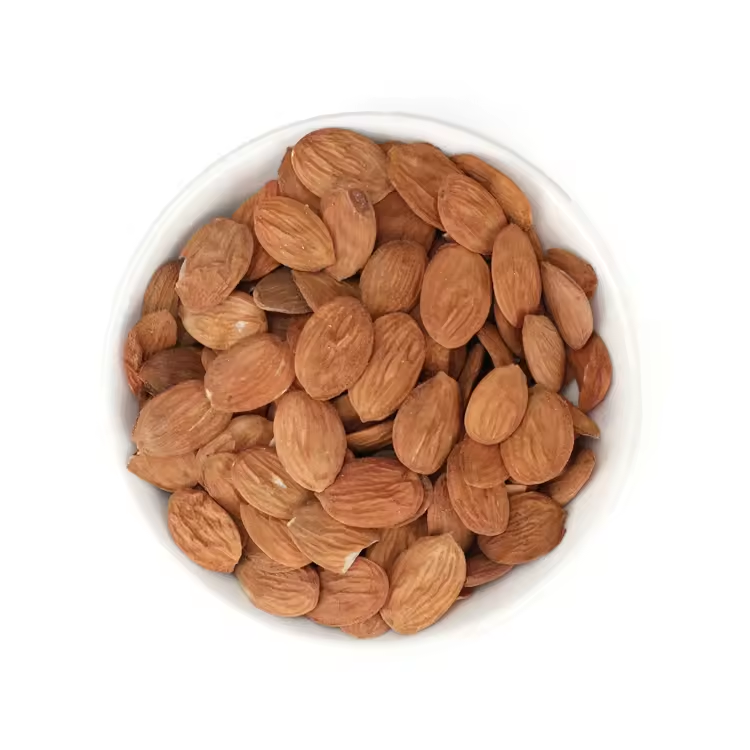
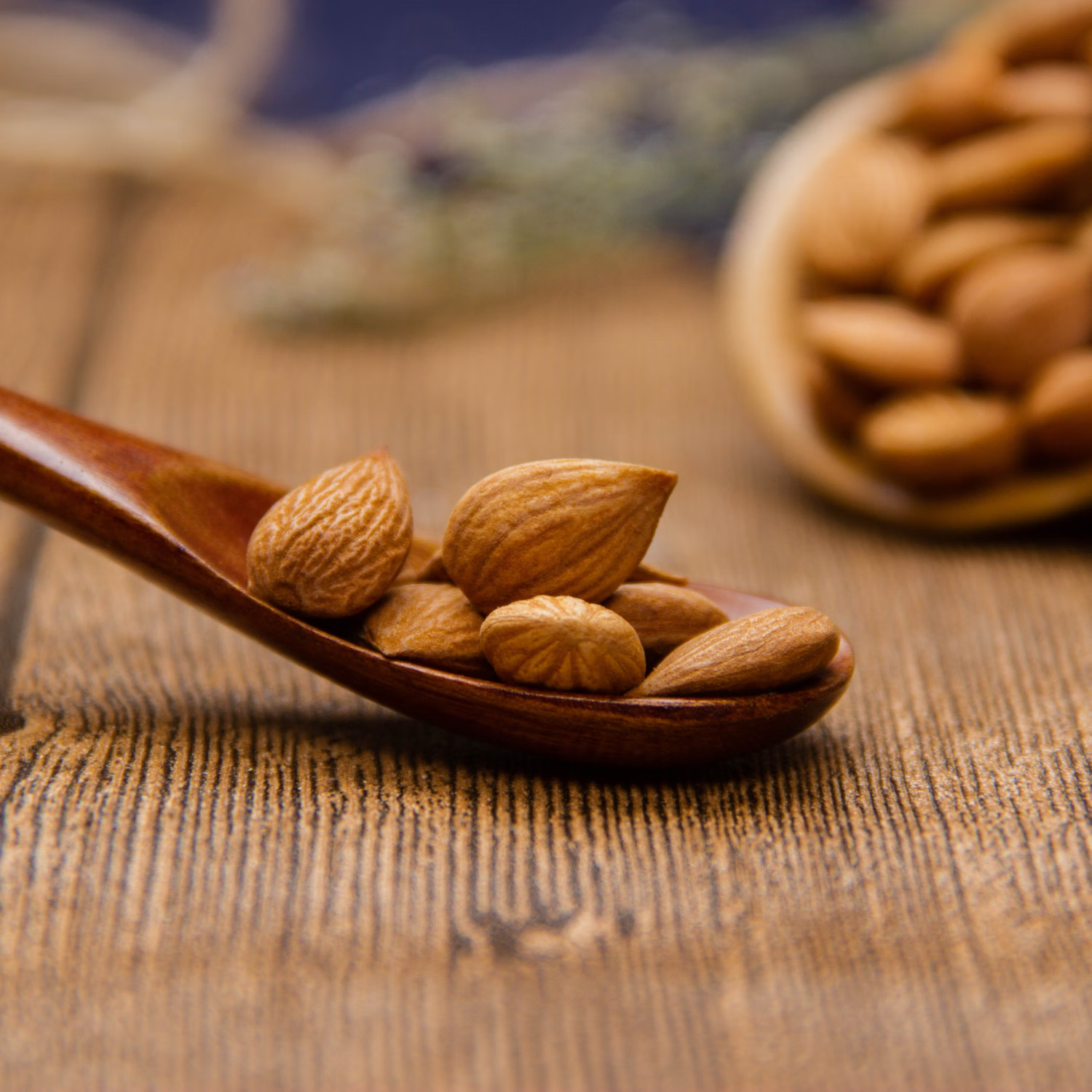



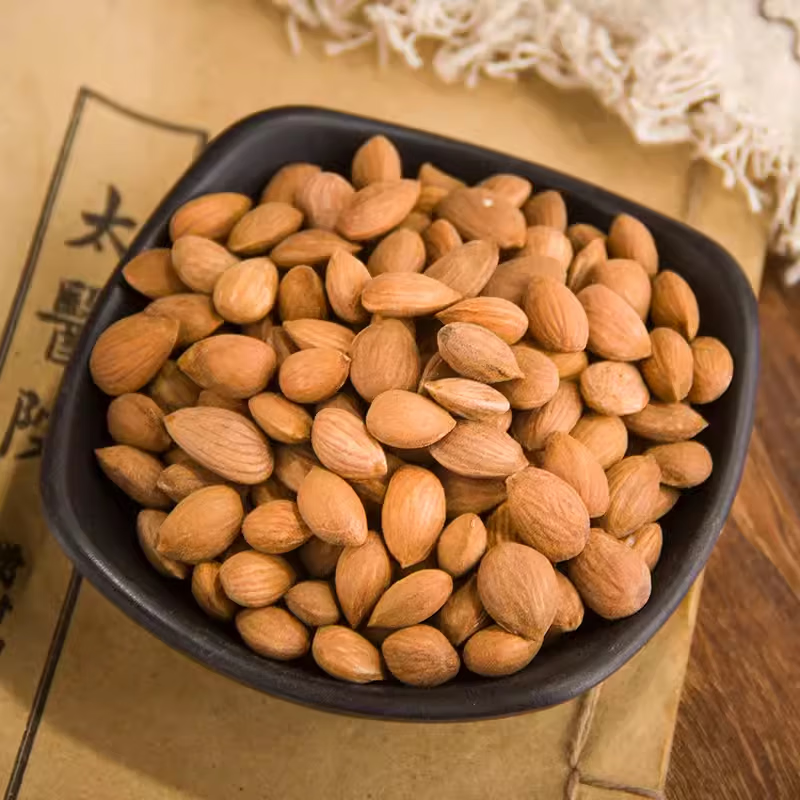
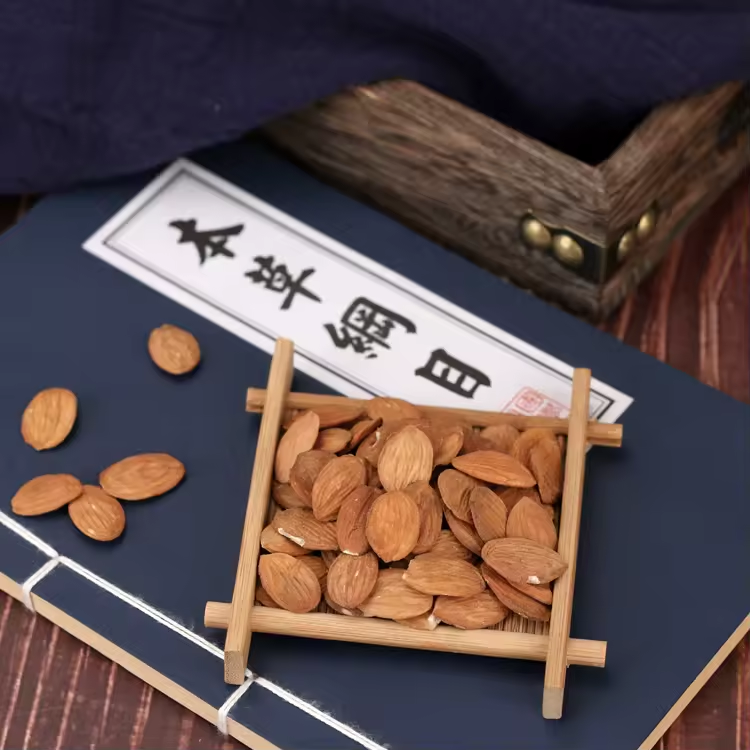
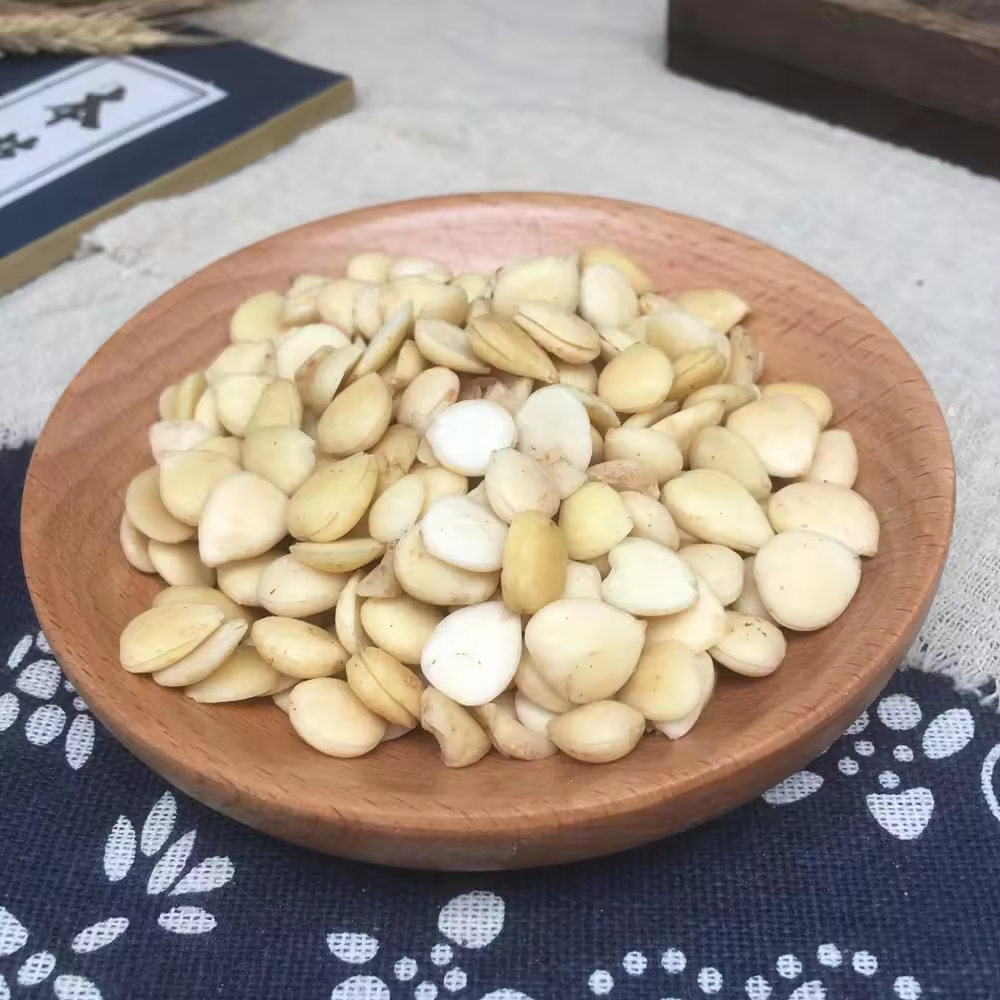

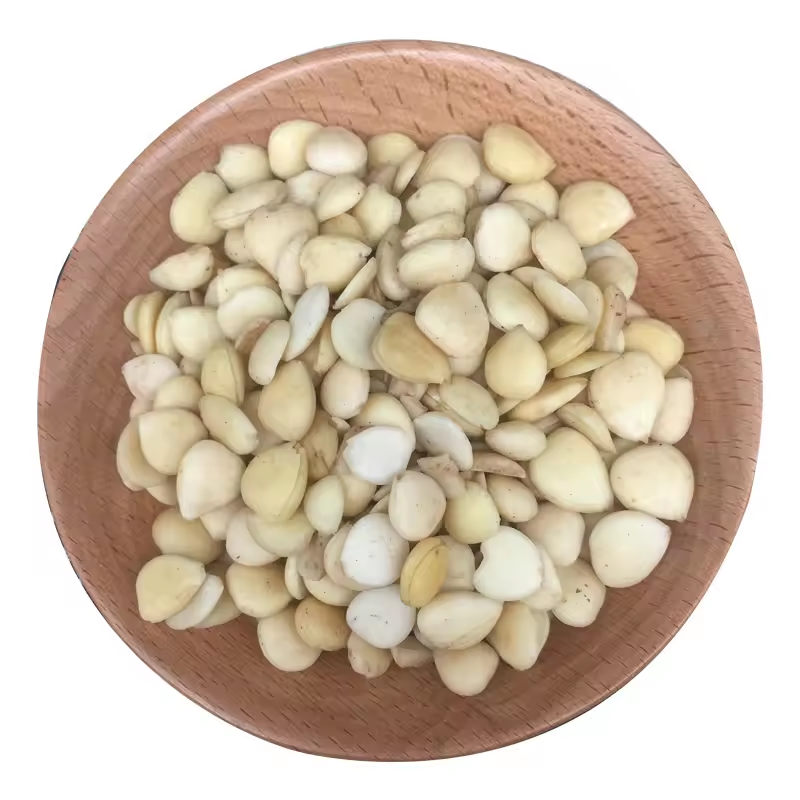

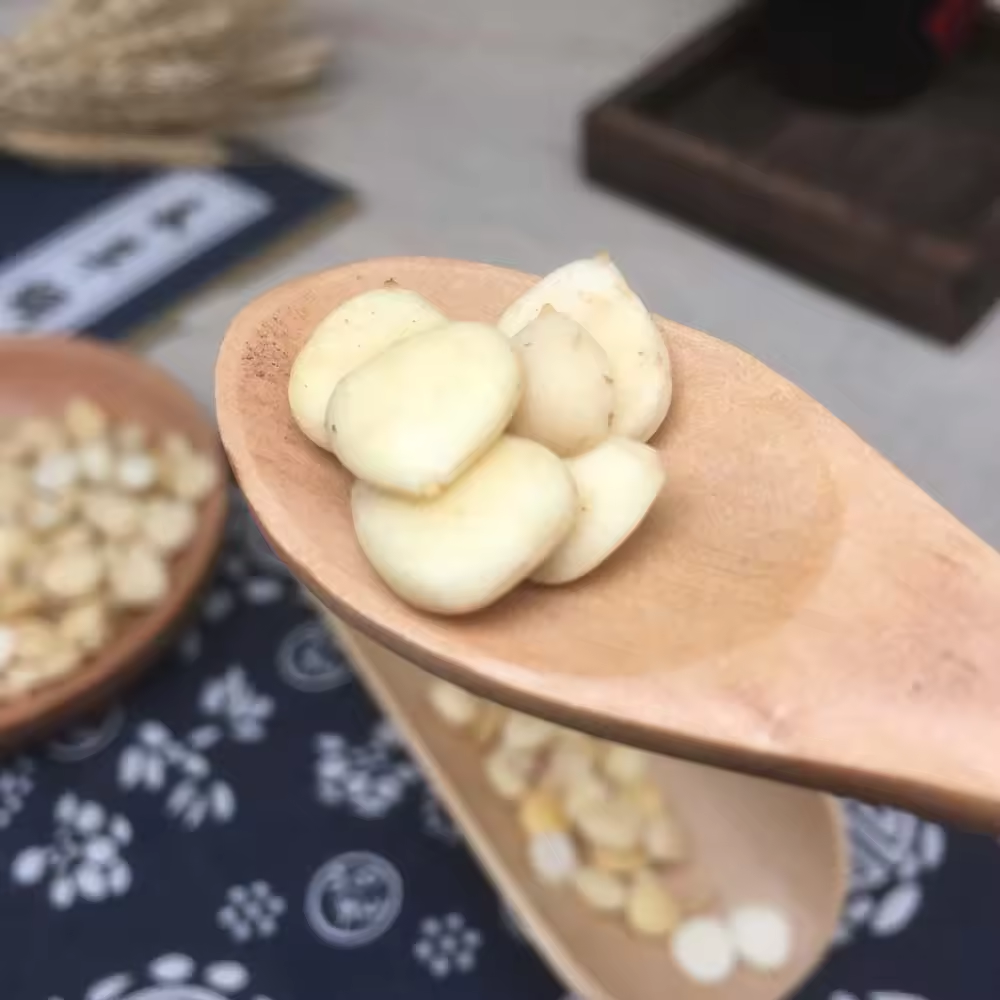
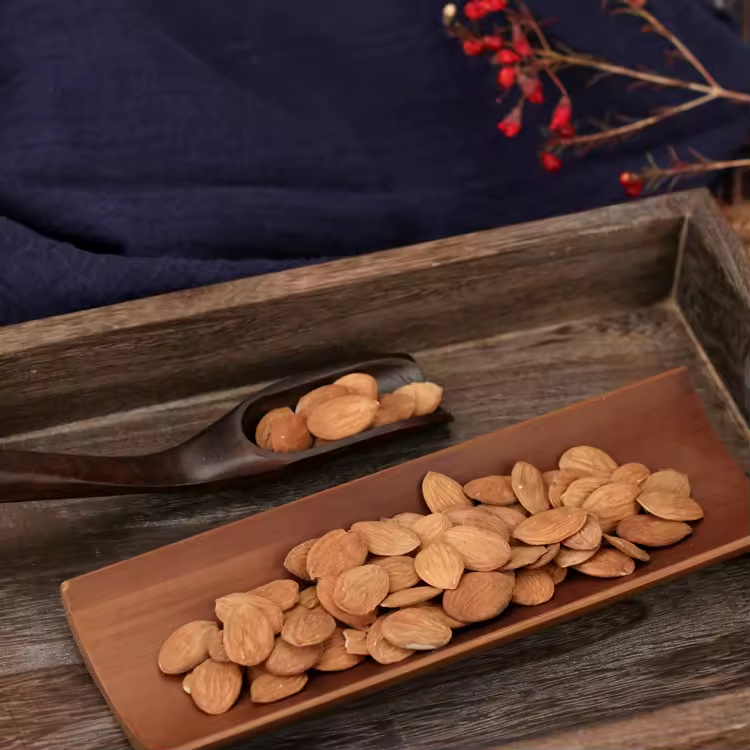
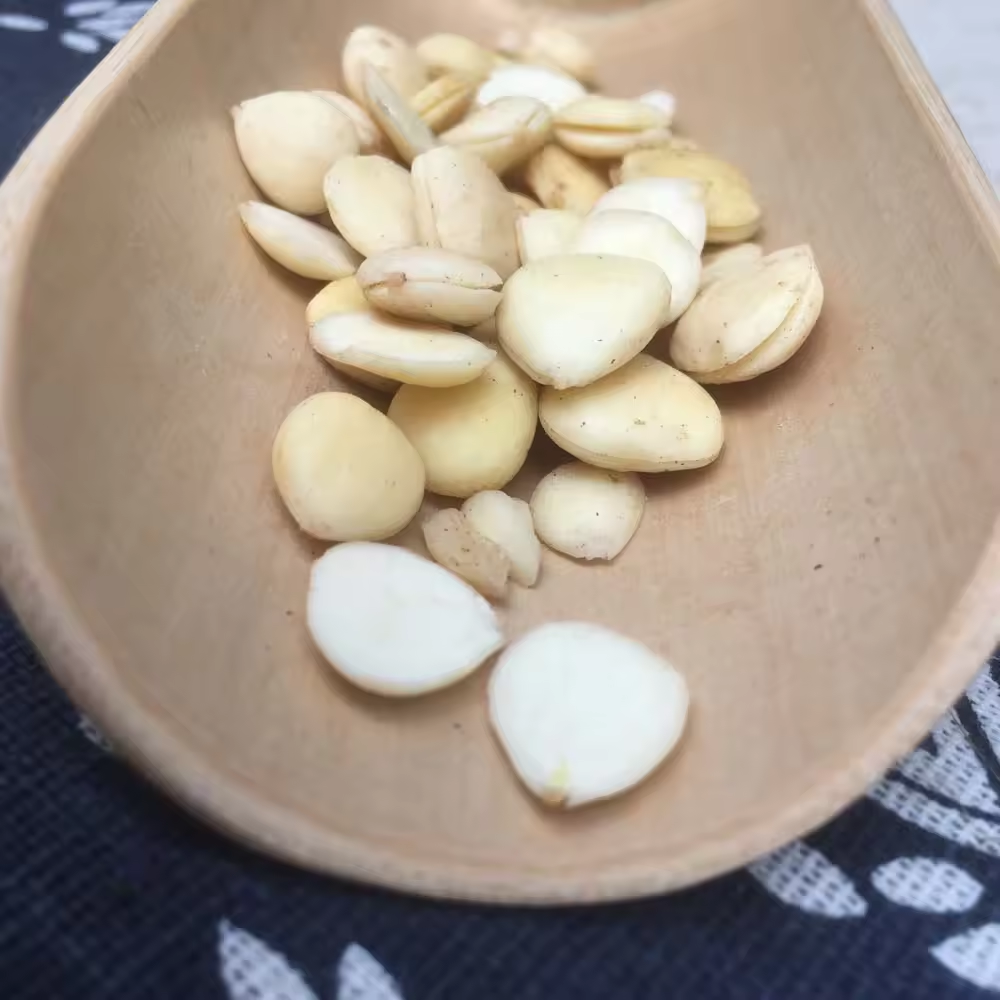


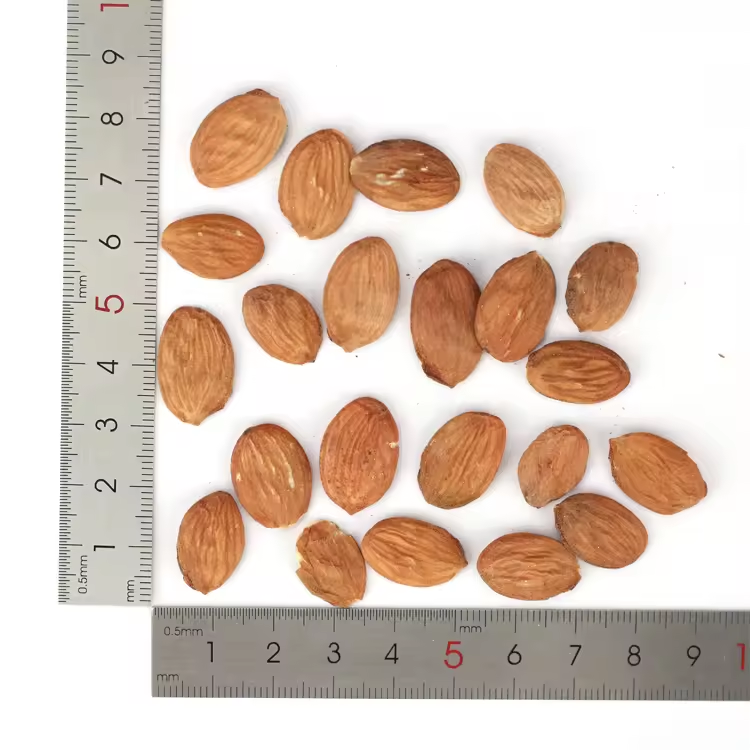
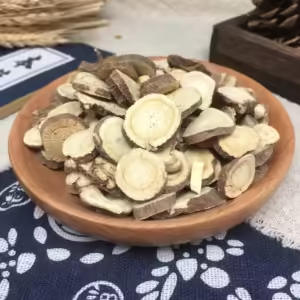
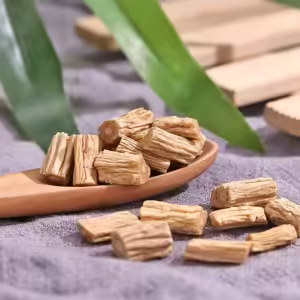
评价
目前还没有评价